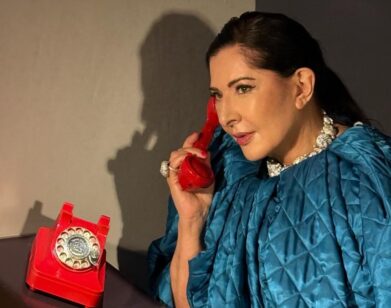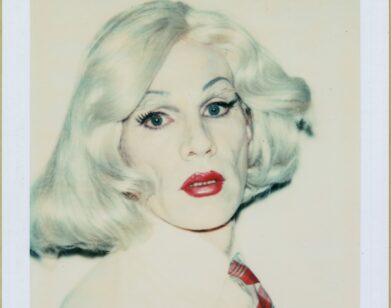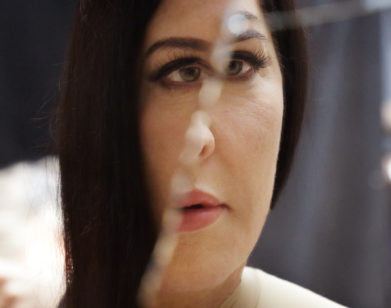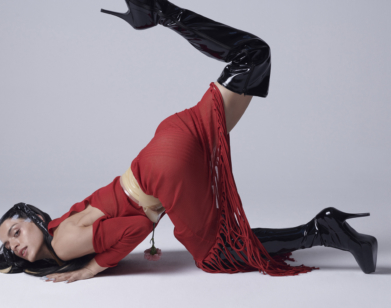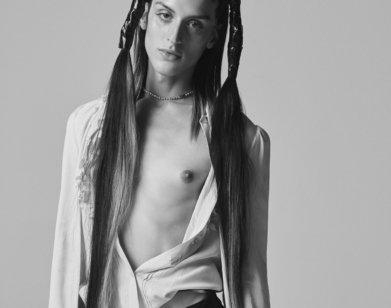Venice Biennale
“I’m Happy to Be an Object”: Miles Greenberg, in Conversation With Klaus Biesenbach
Miles Greenberg first attended the Venice Biennale in utero, and he hasn’t missed one since. A few years later, at the age of 12, an encounter with Marina Abramović’s The Artist Is Present at MoMA set him on the path of performance art. “Understanding that the body could work as raw material inside of the context of a museum exhibition, which is a context that I always responded to much more than the theater, fundamentally shifted something in me,” the 26-year-old artist told the Neue Nationalgalerie director Klaus Biesenbach. Biesenbach, of course, curated Abramović’s notorious retrospective, so when he and Greenberg got together last week, he opted to treat the encounter like a proper studio visit.
This Thursday, at Palazzo Malipiero, Greenberg will present his latest project: an ambitious, provocative performance piece called Sebastian, co-curated by Biesenbach, drawing from the iconography of Saint Sebastian while also centering motifs of the blackamoors, or moretti, who have historically gone unnamed and unacknowledged in the pantheon of classical Venetian art. In their conversation below, Greenberg and Biesenbach get into the physical and conceptual logistics of carrying such a large-scale performance, one which requires Greenberg to stand on a platform for seven-and-a-half hours, slick with dripping oil, as several specially designed arrows pierce his body (the whole thing while be filmed by rotating robotic arms, too). Ahead of the opening, they delved into the politics of performance art, the ecstasy of objectification, and the importance of infusing an ancient city like Venice with living, contemporary art.—JULIETTE JEFFERS
———
KLAUS BIESENBACH: What I would do is treat the conversation a little bit like a studio visit.
MILES GREENBERG: Great.
BIESENBACH: So I have more or less the same set of questions for studio visits.
GREENBERG: Let’s do it.
BIESENBACH: It starts very far away and long ago, but then it will arrive in the here and now. Don’t think in the beginning it’s completely off, because it’s always starting somewhere else. Is that okay?
GREENBERG: I trust you a hundred percent.
BIESENBACH: Super. When did you decide to become a performance artist?
GREENBERG: I have no formal training, my mother was in the theater through my early childhood, so I grew up on a tour bus with Russian absurdist actors and clowns rather than going to daycare. I was exposed to Bouffon and Theater of the Absurd from birth. One day when I was 12 years old on a family vacation, I ended up seeing The Artist Is Present at MoMA – curated by you, obviously. Understanding that the body could work as raw material inside of the context of a museum exhibition, which is a context that I always responded to much more than the theater, fundamentally shifted something in me. It provided the context that eventually became my practice today.
BIESENBACH: So, you’re basically saying at 12 years old you saw Marina Abramović perform at MoMA and you decided to become a performance artist—despite the fact you’re not using that word anymore?
GREENBERG: Pretty much, yeah.
BIESENBACH: What is the goal of a successful performance? For instance, a performance like The Artist Is Present or another.
GREENBERG: I think the goal of a successful performance is the same as the goal of any other artwork, which is to affect the audience—efficiently and wholly—while also transforming the materials in a way that is in line with one’s intentions. In the case of a performance, it’s the body of the artist that’s on the frontlines. It’s undergoing a transformation to induce transformation in the audience, not always predictably or reliably, but constantly generating opportunities for the audience to leave changed.
BIESENBACH: Yeah. For me, a successful performance—and I should look for a better word than successful—is about freezing time. It is leaving both the artist and the audience in a timeless presence. I think that was part of what we wanted to achieve with The Artist Is Present. Because if it’s a painting, if it’s a sculpture, in a certain way art freezes time and creates this timeless presence, then suddenly a work of art is always from tomorrow. So it’s never aging and it’s always here and now, and there’s a certain truth in it and there’s a certain beauty in it to just be present in the very moment, to just look down at yourself and look at your feet, standing here and now, and that’s where you are and when you are. I think that’s always such a grounding moment, no-pun intended. It’s a very rooting, very truthful moment.
GREENBERG: Freezing time in that way might be the goal of all art, not just performance, which is why I think it’s so absurd that performance is so often regarded as some alternative medium when it’s just as efficient as anything else. There’s no such thing as perfect time-proofing in art. If we’re thinking of sculpture, Greco-Roman statuary, for example, as an act of “freezing time”—look at them, they’re all falling apart. Everything falls apart. A big part of my performance practice is looking at the history of sculpture and finding ways in which we can observe the freezing of time, but with a material like a human body that disintegrates much more rapidly and perceptibly. So, as opposed to watching a stone change shape over 700 years, we’re watching a body change shape over seven hours. A developed understanding of temporality on our human, corporal scale is, for me, a big part of what defines performance, and therefore its success.
BIESENBACH: That makes a lot of sense. Because our first collaboration was this performance festival, “Perform!” in Berlin. It’s every Autumn, it’s always the middle of September, and it’s always dedicated to one of the greatest performance artists of our time. The first year was dedicated to Simone Forti. Last year was dedicated to Yoko Ono, and this year will be dedicated to Yvonne Rainer. You were one of the first to participate. And now part of our collection of modern masterpieces at Neue Nationalgalerie – Museum Berggruen will go to Venice. And the situation there is the situation of dialogue. Paul Klee, Matisse, Giacometti, and Picasso are all in dialogue with the masterpieces of the Accademia going hundreds of years back. And you are performing on this occasion, connecting us with here now again.
GREENBERG: I’ve been coming to Venice for a very long time. As you know, I’ve never missed a Venice Biennale in my lifetime, thanks to my mother who brought me every two years, so this is literally a dream come true. My all-time dream is to represent Canada at the Biennale, but this feels pretty damn close.
BIESENBACH: How old were you at your first Venice Biennale?
GREENBERG: Well, I was one, but before that I was in utero. So it’s been every two years of my life from the womb onwards. I haven’t missed one since. In Venice, every two years, the city is barraged with new ideas in this site that is so attached to the ancient, where you feel ghosts.
BIESENBACH: What is your inspiration for this performance, which I am curating together with Lisa Botti in Venice?
GREENBERG: This piece is a portrait of Saint Sebastian. I’ve been thinking about the European canon and these recurring characters from various mythologies and how I can respond to this exercise of depicting religious and mythological figures that has recurred throughout western art history. It’s this perpetual struggle that artists who work in performance tend to run up against, being relegated to the side; it’s like we run parallel to art history and can never be at the center of it. Meanwhile, in Venice, we’re surrounded by Caravaggio, Botticelli, Bernini, who are all sort of reprising over and over these important mythological figures who, in many ways, define us. I think it’s natural that contemporary performance be a viable continuation of that. Similarly, I’ve always been fascinated by how Black people are depicted in classical Italian art, particularly in Venice because you have these ubiquitous blackamoor motifs in the architecture who are largely anonymous yet are constantly present. Saint Sebastian has this dual significance of also being a codified icon to queer artists, past and present. I’ve always had an obsession with him as this figure depicted at this threshold of ecstasy attained through pain or transcendence. I began with a live study for this piece at the Louvre. We made a partial version of it for a video that Donatien Grau commissioned. I designed these arrows with Chris Habana that could go through my skin, and we shot me performing in the closed museum for five hours, but it was kind of like a test. The Venice version is the full-fledged piece, made for a live public this time, for eight hours.
BIESENBACH: Do you remember the first depiction of Saint Sebastian you saw in your life?
GREENBERG: I don’t remember my first Saint Sebastian, but I very clearly remember my first time encountering the moretti, or blackamoors of Venice, who are just as present in this piece. There are these historic Black figures that feature all over Venice. You have these depictions of African slaves or soldiers or noblemen and women whose heads are door handles, or who carry the legs of tables or chairs, or who hold up a vase. They hold the city together in a way, yet recede into the architecture. They’re jet black with this sort of ebony patina, usually handsomely decorated, but often chained to their positions. They’re like three-dimensional silhouettes. And I remember visiting the Ca’ Rezzonico Museum, which is right across the canal from where I’ll be performing at Palazzo Malipiero, where there are these incredible figures by Andrea Brustolon that I was very deeply affected by—maybe part inspiration, part trauma. I was probably 13 years old or so, and I was fascinated with how they had no identity, no origins. Every European figure had a story and a name attached to them, meanwhile these figures didn’t. I think that alienation and that kind of silence and mystery is something I held onto in my way of reappropriating the Black figure.
BIESENBACH: How are you preparing yourself for your performance?
GREENBERG: Well, the day after tomorrow, I leave for Montreal to work with my trainer who’s trained me since 2020. She is an ex-Cirque du Soleil physical therapist who does mostly athletes and musicians now. We’re going to do a week of intensive four-to-five-hour sessions every day.
BIESENBACH: What is the role of the cameras? Because, not to reveal too much, you’ll be standing on a platform for seven-and-a-half hours, but there are also cameras that surveil you, that don’t leave any moment unrecorded.
GREENBERG: It was about extending the arrows that are going through my flesh, to take a step beyond what we accomplished in Paris and kind of extend the form. I love robots and prosthetics, extensions of human will or human gestures. So we’ve got these cameras that will be mounted on these robotic arms performing. The gaze of the cameras to me feels a bit like the natural extension of the arrow, like the probing and the sort of tactile nature of it. The arrows aren’t as violent as they may seem. Both here and at the Louvre, they are placed with enormous care and specificity by a professional. I think it’d be different if the piece were performed by another person, but the fact that it’s me doing it to myself is, to me, an unviolent dynamic. Because the piece and the way it’s captured is a situation of my own invention, I also want to invite the reading that the way the cameras are looking at my body, capturing the details of the wounds, could also be an act of care, or an act of sort of sensuality. It could be erotic, or autoerotic. I’m thinking just as much as the invasive gaze of the cameras as the gaze that’s maybe more romantic. I’m thinking of waking up before a lover after sharing a bed overnight and being able to see the rising and falling of their chest; the details of their skin, the way they breathe, or move unconsciously. I think those are all also the roles of these cameras and their position and the performance.
BIESENBACH: Will your mother come see the performance?
GREENBERG: She’ll be there. I’m trying to get her to be a part of it. It’s a big moment for us because it’s 26 years in the making, in a way. Klaus, how do you see the connection between our performance, the Berggruen modern collection and this Accademia show? What is the relevance and the importance of having new ideas in an ancient city like Venice?
BIESENBACH: The very first time I went to the Venice Biennale was 1993, and I took a train from Berlin. And on the train in Innsbruck in the middle of the night, a stranger wanted to get into my train compartment and I wanted to sleep. And that stranger, who I didn’t know before, was Hans Ulrich Obrist. So, we met on a night train to Venice, which is the opening of the Venice Biennale. He had to leave in Mestre because he had to go to something. And then I arrived in Venice and I remember, at the time, there was something called Aperto, and Aperto was the section of the very contemporary, the very emerging. And I was deeply impressed by this section. And then my next biennial, 1995, the more conservative director of the Biennale had not continued Aperto. So then I thought, “Let’s do our own Aperto.” It was performances and interventions and music and an internet congress. And it was 72 hours, day and night, day and night, day and night. And Mario Codognato, who is also working with us now on your performance, he and I worked together as a team with many artists on that project. It was called Club Berlin. And artists like Marina Abramović performed in that club. She offered gold drinks one night. This is now 29 years ago. For me, Venice has a tradition of connecting millennia and eras and cultures. And it’s also the idea of Venice being an international biennial. It’s also intergenerational and it’s also between worlds because, as you mentioned before, the past is still very present in Venice. And when you described visiting Accademia for your research, how did you observe the sculptures, the paintings? Did you take pictures? Did you make drawings? I remember when I was a young student, I was a medical student and then an art student, and in medical school we had to do anatomical drawings. How did you do your drafts and research, and how did you approach Venice in 2024, when you were preparing Sebastian?
GREENBERG: First of all, I love our connection with anatomy and medicine because that’s something that I’m highly obsessive about when it comes to performing. When I arrived in Venice, I had three things I was looking for: I wanted depictions of Saint Sebastian, depictions of Black folks, and depictions of lilies, because lilies are always recurring as a symbol that god is present. So, we’re going to have these three elements in the Venice performance. I wanted to find these blackamoor sculptures. I went and 3D scanned a bunch of them, more than a dozen them, just with my phone, often without permission. Just very rudimentary, quick 3D scans. I wanted to research their movement in order to bring them into the performance somehow. But the act of going over them with my device, over and over, and trying to make sure that I get every detail of their faces, of their bodies, of their arms, of their chains, of their wounds, of their feet—that process was a process of care. I think it reflects very much in the cameras that we’re going to be using in the performance, this action of scanning these anonymous Black bodies in the fabric of the city. But also, because I wanted to somehow find a way to reappropriate them, this gesture of guerrilla scanning became this subtle act of liberation.
BIESENBACH: I have one strange question. for the moment you’re performing, does it make you feel more like an object or does it make you feel more like a human being there in still motion?
GREENBERG: I feel I’m quite happy to be an object. I think that’s always the goal, in a way. I want to become a thing. I think the abstraction and complexity of human life is something that I guess I sometimes struggle with outside of my practice in a way. Sometimes I really like the fact of being able to recede into thingness, to just be a collection of molecules and cells. I’m always trying to make the brain feel like just another part of the body again. The brain and the mind are like these abstract things that are somewhere floating above us that we’re all just colliding with and filling with tasks. But I think the ideal space to be in for a performance is the space of just being in one’s body in that liminal hypnosis of duration where you no longer grasp yourself as an identity but rather as a homeostatic thing that has to respond to stimuli.
BIESENBACH: When I was in primary school, my art teacher, and I’m still grateful for him, took a masterclass in Düsseldorf with Joseph Beuys. He would come in from his class buzzing with energy because he had just come from the incredibly inspiring teaching of Joseph Beuys, and he was saying, “Art has to be political, art has to be performative. Performance has to be an agent, it has to be responsible, it has to be ecological.” It’s a very specific approach, I would say. For you, are you considering yourself as an agent for something when you perform or do you feel more autonomous and not want to be categorized into any direction?
GREENBERG: Yeah, I think I’d rather be autonomous. I think the reason for that being that I need enough room for magic in everything that I do. The unexpected, the serendipity, l’imprévisible, in French. It’s Suzanne Césaire’s definition of surrealism as a “permanent state of readiness for the marvelous.” It’s hard for me to talk about performances before they happen because I often don’t know what they’re about until they happen. And as much as I have a shape and I know exactly what it looks like and exactly what it does, I can’t really tell you what it did until it’s done. There has to be so much room for that spontaneity and I think that carries over into my sculptures as well as my videos.
BIESENBACH: I think I freed myself over the decades from that quite specific viewpoint of my primary school art teacher. [Laughs] I’m much more open. Where I still agree with him is that art has to change how you look at the world. And I actually think people will leave your performance in Venice and go to a palazzo and go to a church and see the sculptures slightly differently after they have visited your performance. I think it’s actually a very intriguing coexistence of contemporary, of modern, of more classical, of historical and of digital. So I’m very curious, and curiosity is important, that you are so courageous to do that for seven-and-a-half hours. So a huge thank you, Miles.
GREENBERG: Thank you for having me. This is like being invited to compete at the Olympics.
BIESENBACH: I’m really excited, too. Let’s reflect on it again after the performance.
GREENBERG: We just have to be excited, and we just have to do it.





